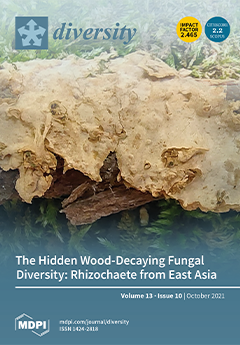There are two pygoscelid penguins, the Gentoo (
Pygoscelis papua Forster, 1781) and Adélie (
P. adeliae Hombron and Jacquinot, 1841) penguins, breeding sympatrically on Ardley Island, Fildes Peninsula region, South Shetlands, Antarctica. Whether the two closely related penguin species with similar dietary
[...] Read more.
There are two pygoscelid penguins, the Gentoo (
Pygoscelis papua Forster, 1781) and Adélie (
P. adeliae Hombron and Jacquinot, 1841) penguins, breeding sympatrically on Ardley Island, Fildes Peninsula region, South Shetlands, Antarctica. Whether the two closely related penguin species with similar dietary habits possess compositional similarity in gut microbiota remains unknown. DNA barcoding of feces is an emerging approach for gut microbiota analysis of protected animals. In the present study, the 16S rRNA gene from penguin feces was sequenced using the Illumina MiSeq platform to investigate the gut microbiota of the two pygoscelid penguin species. The fecal community of Gentoo penguins has higher diversity indices and OTU (operational taxonomic unit) richness compared to Adélie penguins. Besides unclassified bacteria, sequences fell into 22 major lineages of the domain Bacteria: Acidobacteria, Actinobacteria, Armatimonadetes, Bacteroidetes, Chlamydiae, Chloroflexi, Cloacimonetes, Cyanobacteria, Deinococcus-Thermus, Fibrobacteres, Firmicutes, Fusobacteria, Gemmatimonadetes, Ignavibacteriae, Planctomycetes, Proteobacteria, Tenericutes, Verrucomicrobia, and candidate divisions BRC1, SR1, WPS-2, and Saccharibacteria. Among these, Firmicutes (37.7%), Proteobacteria (23.1%, mainly Gamma- and Betaproteobacteria), Fusobacteria (14.3%), Bacteroidetes (7.9%), and Actinobacteria (6.6%) were dominant in the fecal microbiota of the two penguin species. At the same time, significantly higher abundances of Actinobacteria and Cyanobacteria were detected in Gentoo penguins than in Adélie penguins (
p < 0.05). Overall, there was a clear difference in the composition of gut microbiota between the Adélie and Gentoo penguins. The results suggested that both the phylogeny of penguin species and the diet could be responsible for the differences in the gut microbiota of the two pygoscelid penguins breeding in the same area.
Full article





